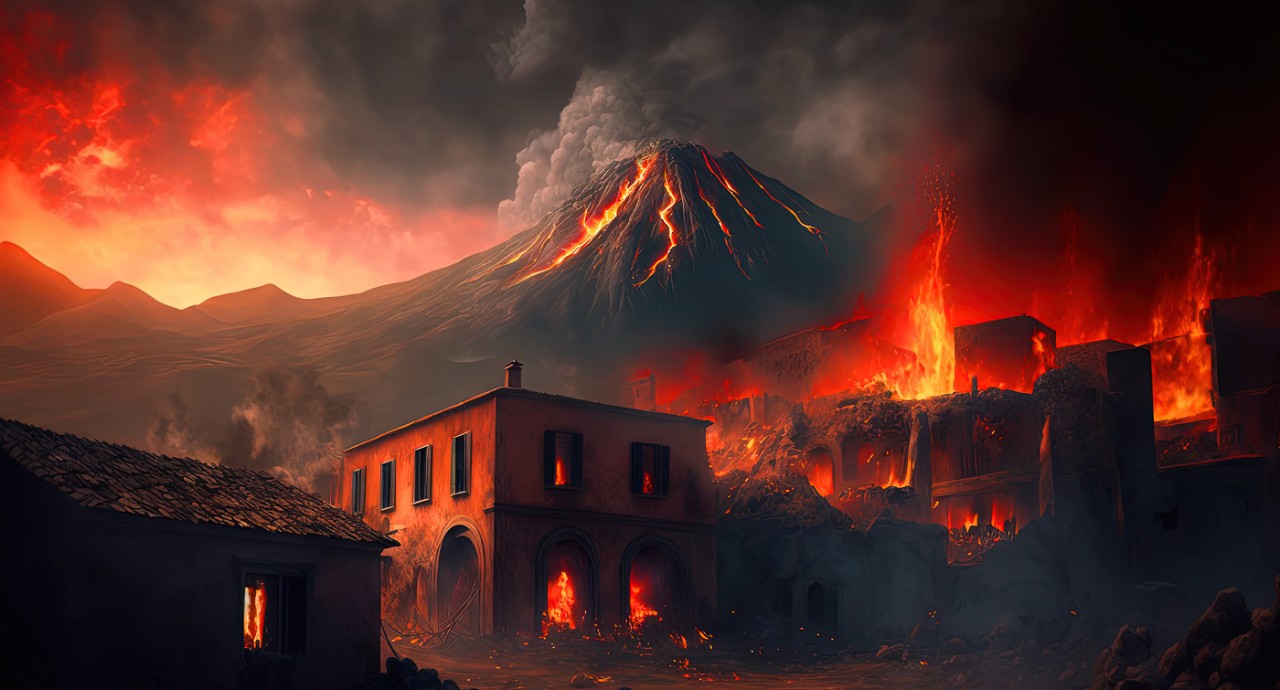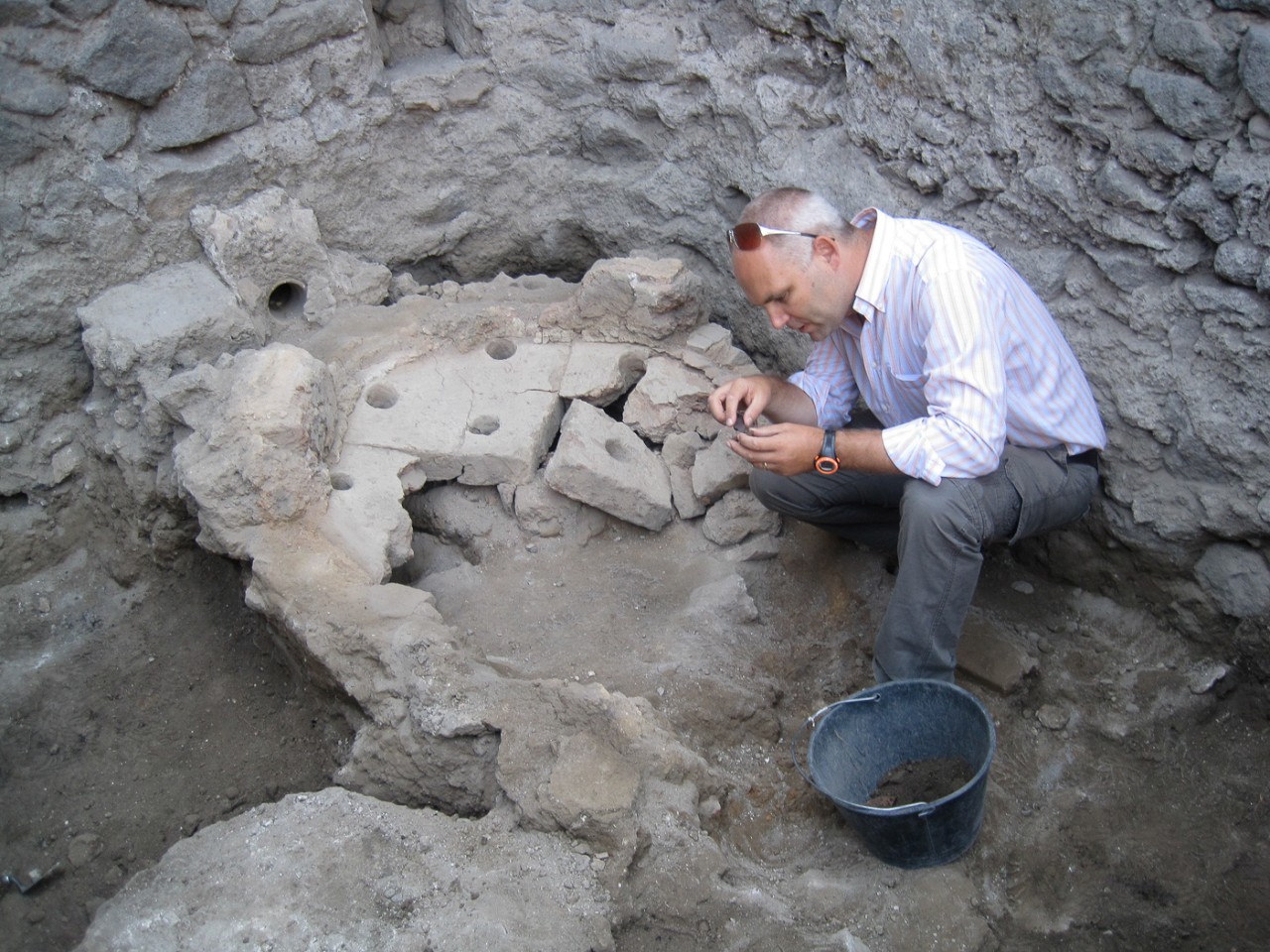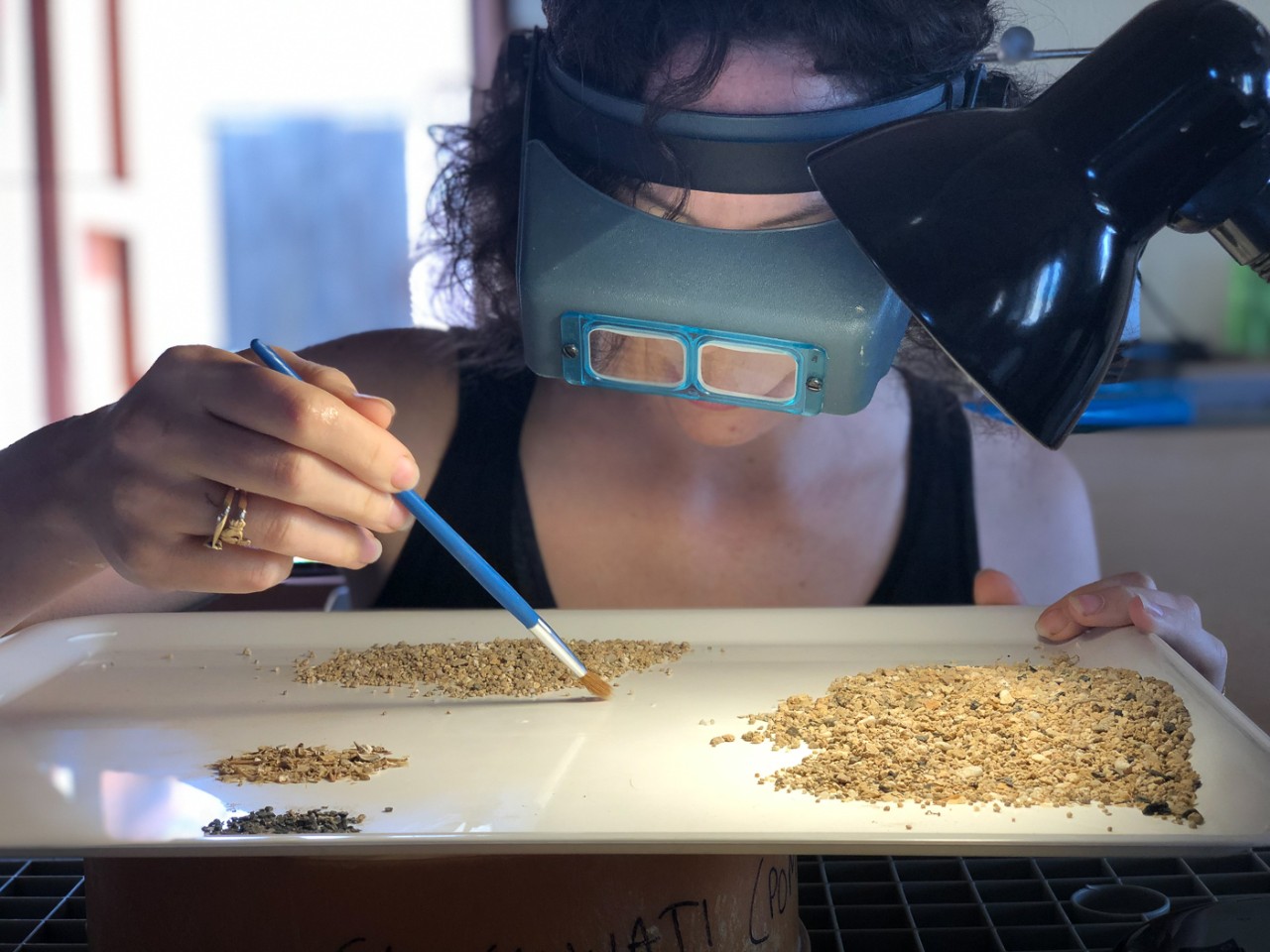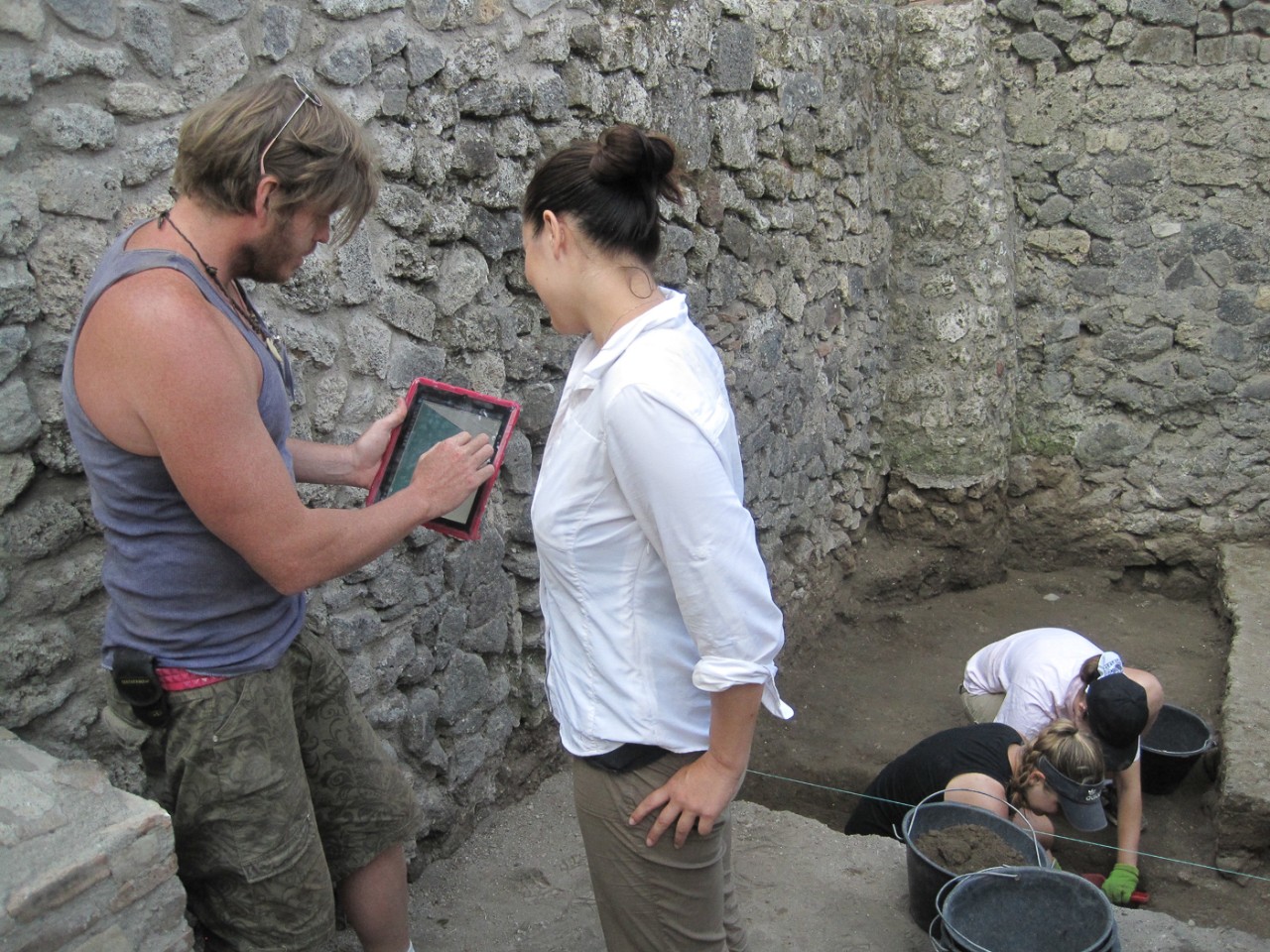
UC expert helps museum's 'Pompeii' come to life
UC Classics professor shares expertise in new Cincinnati Museum Center exhibit
Roman archaeologist Steven Ellis often thinks about the last day of Pompeii as city residents went about routine errands at markets nearly 2,000 years ago.
The University of Cincinnati Classics professor led excavations in the city’s Porta Stabia neighborhood, a retail area of restaurants, shops and homes. That afternoon in A.D. 79, the ground shook and a rumble emanated from the mountain that cast its long shadow across the city.
The volcano Mount Vesuvius was erupting.

Steven Ellis co-wrote the first of four volumes on UC's excavations on Pompeii.
“It’s not just any eruption but a type now considered one of the most explosive of volcanic eruptions,” Ellis said. “They see a mushroom cloud shooting up and darkening the skies with this huge cloud of gas and pumice and ash. Day becomes night.
“They likely imagine it’s the absolute end of the world,” he said.
Ellis and his students have learned a lot about daily life in the months and years leading to the cataclysm that entombed Pompeii beneath as much as 30 feet of ash. His discoveries are shaping what we know about the city’s class structure, economy and culture.
Ellis last year published the first of four historical volumes on his work starting in 2005 as director of excavations at Pompeii’s Porta Stabia. Now he is lending his expertise to a new exhibit on Pompeii at the Cincinnati Museum Center.
Pompeii: The Exhibition
The Cincinnati Museum Center's Pompeii: The Exhibition opens Feb. 16 through July 28 at Union Terminal. Exhibition admission required.
“Pompeii: The Exhibition” opens at the museum on Feb. 16. It features 150 priceless artifacts from the ancient city.
“Pompeii is a remarkable story that exists as both ancient legend and archaeological treasure, providing a timeless snapshot of daily life in the Roman Empire,” said Elizabeth Pierce, president and CEO of Cincinnati Museum Center.
“We’re incredibly fortunate to be able to call upon Dr. Ellis and share his perspective and expertise,” museum spokesman Cody Hefner said.
Pompeii has attracted more intensive academic research across more languages and over a longer period than any other.
Steven Ellis, UC Classics
“At Cincinnati Museum Center we pride ourselves on being able to bring the world to Cincinnati through exhibitions like 'Pompeii.' Having a partner in the University of Cincinnati and Dr. Ellis gives us opportunities to reveal the ancient city of Pompeii in fascinating depth and charismatic detail.”
UC Classics’ project aimed to uncover the livelihoods of ordinary residents who lived in Pompeii, not just at the moment the city was destroyed but in the generations leading up to the cataclysm as the city was built and rebuilt.
“We were able to look at this really interesting texture of a Roma neighborhood that existed in A.D. 79 but then to go down underneath it,” he said. “We excavated through all the layers of urban development. Pompeii is the product of hundreds of years of urbanization.”

A drone shot shows the ancient city of Pompeii in the shadow of Mount Vesuvius. Photo/Steven Ellis/UC Classics
The neighborhood Ellis uncovered was a retail district consisting of nearly a dozen properties across two multilevel structures just inside one of Pompeii’s seven main entrance gates. The buildings contained retail shops and entertainment spaces where generations before stood the workshops of skilled trades workers. There they made pottery and tanned hides and salted fish for distribution.
“Originally, it was a neighborhood that was built upon production, upon labor and the manufacturing of goods,” he said. “It’s very much retail-oriented.”
Ellis and his research collaborators tried to learn more about the social and structural makeup of the city and put it in context of the Roman Mediterranean.
“While it wasn’t Rome or Constantinople, one of the megacities of the ancient world, Pompeii is regionally important,” Ellis said.

An Illustration depicts the Porta Stabia neighborhood before the volcanic cataclysm in 79 A.D. Illustration/Gareth Blayney for UC Classics
The site has provided archaeologists with a bonanza of information about this ancient civilization because it preserved hundreds of thousands of artifacts across more than 1,000 city properties.
“Pompeii has attracted more intensive academic research across more languages and over a longer period than any other,” Ellis wrote in his 2023 book.

UC College of Arts and Sciences Associate Professor Steven Ellis directed the excavation of the Porta Stabia neighborhood at Pompeii. Photo/UC Classics
Researchers created an enormous database of information relating to artifacts and their significance as they excavated the entire former neighborhood and what lay there previously.
The buildings in this working-class neighborhood were modest and did not feature homes with large atriums common to other neighborhoods in the city.
By analyzing the food scraps found in the buildings, they recreated the menu at the restaurants. In one, they find evidence of locally harvested seafood, meats, grains and vegetables. But at another establishment, they find a richer variety of foods, ingredients and spices, some imported from distant places.
“They have both more and a greater range of everything — higher priced cuts of meat, a greater range of seafood and more interesting flavorings,” Ellis said.
These included sesame seeds and peppercorns imported from far beyond the city. They also found evidence of a variety of fish, chicken and pork along with fresh fruits, coriander and olives. The strangest discovery was a butchered leg of a giraffe, the provenance of which is a subject of debate.

UC Classics led the excavation of the Porta Stabia neighborhood of Pompeii. A painstaking analysis allowed them to recreate the menus of the city's restaurants more than 2,000 years ago.. Photo/Steven Ellis/UC Classics
Excavations also uncovered more than 1,000 coins. Most were found in shops where you might assume they were collected as payment for goods or services. But Ellis found that the vast majority of the coins had been lost by chance or accident in loose fill that occupants used to build up foundations for new construction over generations.
Coins appeared more often in the shops than residences because the shops were subject to frequent remodeling necessitating more fill with each new construction project.
The excavations at Pompeii join a storied list of UC Classics scholarship in the ancient world, from the lost city of Troy to ancient Greece. Since 2005, UC has been leading excavations at Pompeii as part of an international project.
“Cincinnati has a really rich history in the study of Pompeii. UC has been at the forefront of what we now understand about the city, how it developed over time, what kinds of people they were, what kinds of houses they lived in and the kinds of shops they ran,” said Ellis.
“It’s a really privileged opportunity for Cincinnati to conduct this scholarship.”

UC Classics' excavations at Pompeii's Porta Stabia neighborhood found that retail shops and restaurants had replaced workshops of skilled tradespeople. Photo/Steven Ellis/UC Classics
The city’s history ended abruptly with the explosive eruption, which rained fiery rock and ash down upon the city.
“People are screaming. They’re running into the hills or trying to make their evacuation by sea,” he said. “Some are huddled in small rooms of their homes, trying to wait it out.”
Survivors witness a cataclysm on a scale never previously recorded, Ellis said.
Violent earthquakes in the days before the eruption prompted many residents to flee the city. A teenager named Pliny the Younger and his family fled their home outside the city. His letters to historian Tacitus described “a black and dreadful cloud, broken with rapid, zigzag flashes, revealed behind it variously shaped masses of flame” that rose above the volcano. The uncle who raised him, Pliny the Elder, died while rescuing villagers by boat who were trapped at the base of the volcano.
Ash blackened the sky and rained down on him and his mother as they fled high into the surrounding hills. When the sun returned, still obscured in haze, they saw everything “covered deep with ashes as if with snow.”
The pyroclastic clouds that covered the city engulfed victims who likely asphyxiated from the toxic fumes. People, pets and livestock were incinerated, leaving voids in the ash bed that archaeologists later filled with plaster to reveal how they met their last moments.
“There’s the immediacy of Pompeii that really captivates us. What’s especially poignant is that we sadly see not just the city destroyed but the people themselves. And it’s a quite touching experience to see those last horrific moments captured,” Ellis said.
Featured image at top: An illustration created with AI depicts the eruption of Mount Vesuvius at Pompeii. Illustration/Visilli

UC Classics Associate Professor Steven Ellis is a Roman archaeologist who has investigated ancient civilizations across Europe and Africa. He has led excavations at Pompeii, Sardinia's Tharros and in East Isthmia in Greece. Photo/Andrew Higley/UC Marketing + Brand
Impact Lives Here
The University of Cincinnati is leading public urban universities into a new era of innovation and impact. Our faculty, staff and students are saving lives, changing outcomes and bending the future in our city's direction. Next Lives Here.
Related Stories
UC expert helps museum's 'Pompeii' come to life
February 13, 2024
University of Cincinnati Classics Professor Steven Ellis last year published the first of four historical volumes on his work as director of excavations at Pompeii’s Porta Stabia neighborhood. Now he is lending his expertise to a new exhibit on Pompeii at the Cincinnati Museum Center. “Pompeii: The Exhibition” opens at the museum on Feb. 16. It features 150 priceless artifacts from the ancient city.
Greece honors two UC Classics researchers with ‘Order of Phoenix’
April 19, 2021
The president of Greece honored University of Cincinnati Classics researchers Jack Davis and Sharon Stocker by bestowing upon them one of the country’s most prestigious awards, Commander of the Order of the Phoenix. The two made several groundbreaking archaeological discoveries in Pylos that are shaping our understanding of ancient Greece.
How to spot a fake
December 6, 2022
University of Cincinnati chemists, geologists and art historians are collaborating to help area art museums answer questions about masterpieces and detect fakes — and teaching students about their methods.
